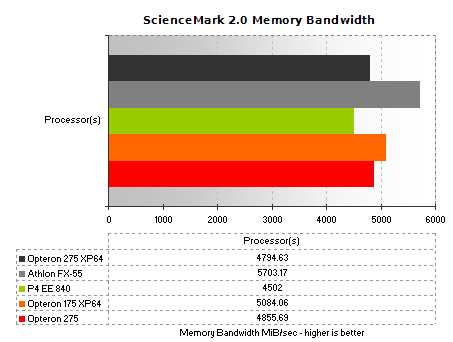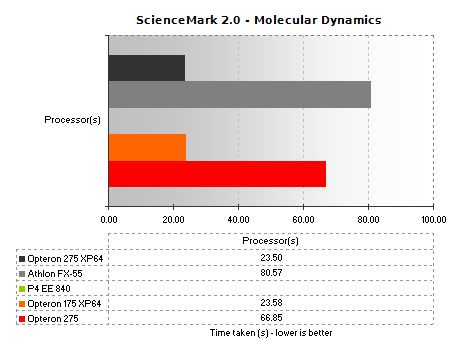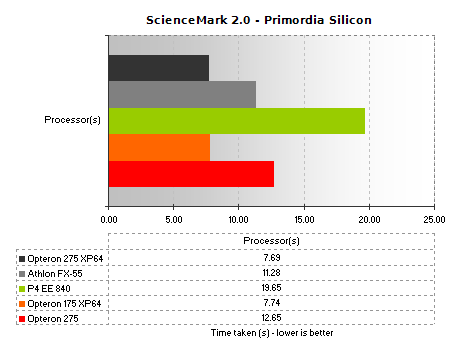ScienceMark 2.0
ScienceMark 2.0 provides us with an number of interesting benchmarks, including memory subsystem tests and single and multi-threaded scientific simulations.ScienceMark 2.0 Memory Bandwidth

The use of registered memory with 3.0-3-3-8 timings on the Opterons robs them of ~700MB/sec of bandwidth as measured by ScienceMark 2.0, compared to the 2.0-2-2-5 DDR400 low-latency stuff used with the FX-55. The single Opteron 175 measures slightly higher than the dual processor system, and all the AMD systems outpace the lacking Pentium 4 in raw terms.
ScienceMark 2.0 Memory Latency

Under Windows XP 64-bit, the single Opteron 175 can access system memory slightly faster than the dual Opteron 275. Registered memory and lax timings do the rest to lag the FX-55 by over 30%. The Pentium 4 brings up the rear. On-die memory controllers do the business.
ScienceMark 2.0 Molecular Dynamics

The MolDyn benchmark is multi-threaded and under Windows XP 32-bit the FX-55 trails the Opteron 275 system, four cores accelerating the test faster than the desktop powerhouse can.
Under XP 64-bit the test speeds up massively. There are only two computation threads in the MolDyn test, with the single Opteron 175 matching the dual Opteron 275 for performance. The combination of a 64-bit OS and CPU, and multi-threading, makes for massive performance leaps. The 840 EE wasn't around long enough for us to run MolDyn for comparison.
ScienceMark 2.0 Primordia Silicon

Primordia is multi-threaded, but the test shows the 2.6GHz single-core FX-55 besting the four-core Opteron 275 test system, under Windows XP 64-bit. The element we choose, Silicon, doesn't seem to allow the multi-threaded nature of the test, with two threads, to surface. Lots of core clock and low latency memory are faster.
Under XP 64-bit performance increases nearly twofold. The single Opteron 175 is as fast as the dual Opteron 275, as you'd expect from a two-thread test.
So initially, what we're seeing is a dual-core processor effectively doing as well as two discrete single-core processors would, when threading is limited to only two threads. Along with that, we're seeing huge gains to be made by running a native 64-bit binary of the same program under a 64-bit OS.









